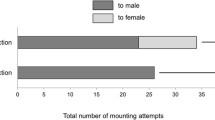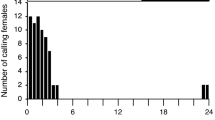Abstract
Females ofPolistes fuscatus possess a sex pheromone in the venom gland and sac. The pheromone attracts males from short distances and releases male copulatory behavior.
Similar content being viewed by others
References
Buschinger, A. 1972. Giftdrüsensekret als Sexualpheromon bei der AmeiseHarpagoxenus sublaevis.Naturwissenschaften 59:313–314.
Buschinger, A. 1974. Zur Biologie der sozialparasitischen AmeiseLeptothorax goesswaldi Kutter (Hym., Formicidae).Insect. Soc. 21:133–144.
Buschinger, A. 1976. Giftdrüsensekret als Sexualpheromon bei der GastameiseFormicoxenus nitidulus (Nyl.) (Hym., Form.).Insect. Soc. 23:215–226.
Buschinger, A., andAlloway, T.M. 1979. Sexual behaviour in the slave-making ant,Harpagoxenus canadensis M.R. Smith, and sexual pheromone experiments withH. canadensis, H. americanus (Emery), andH. sublaevis (Nylander) (Hymenoptera; Formicidae).Z. Tierpsychol. 49:113–119.
Buschinger, A., Francoeur, A., andFischer, K. 1980. Functional monogyny, sexual behavior, and karyotype of the guest ant,Leptothorax provancheri Emery (Hymenoptera, Formicidae).Psyche 87:1–12.
Butler, C.G. 1971. The mating behavior of the honeybee (Apis mellifera L.).J. Entomol. 46:1–11.
Gary, N. 1962. Chemical mating attractants in the queen honey bee.Science 136:773–774.
Hölldobler, B. 1971. Sex pheromone in the antXenomyrmex floridanus.J. Insect Physiol. 17:1497–1499.
Hölldobler, B. 1976. The behavioral ecology of mating in harvester ants (Hymenoptera: Formicidae:Pogonomyrmex).Behav. Ecol. Sociobiol. 1:405–423.
Hölldobler, B., andHaskins, C.P. 1977. Sexual calling behavior in primitive ants.Science 195:793–794.
Hölldobler, B., andWüst, M. 1973. Ein Sexualpheromon bei der PharaoameiseMonomorium pharaonis (L.).Z. Tierpsychol. 32:1–9.
Jeanne, R.L. 1982. Evidence for an alarm substance inPolistes canadensis.Experientia 38:329–330.
Noonan, K.M. 1978. Sex ratio of parental investment in colonies of the social waspPolistes fuscatus.Science 199:1354–1356.
Post, D.C., andJeanne, R.L. 1983. Male reproductive behavior of the social waspPolistes fuscatus (Hymenoptera: Vespidae). Z.Tierpsychol. In press.
Shorey, H. 1976.Animal Communication by Pheromones. Academic Press, New York.
West-Eberhard, M.J. 1969. The social biology of polistine wasps.Misc. Publ. Mus. Zool. Univ. Mich. 140:1–101.
Author information
Authors and Affiliations
Rights and permissions
About this article
Cite this article
Post, D.C., Jeanne, R.L. Venom Source of a sex pheromone in the social waspPolistes fuscatus (Hymenoptera: Vespidae). J Chem Ecol 9, 259–266 (1983). https://doi.org/10.1007/BF00988043
Received:
Revised:
Issue Date:
DOI: https://doi.org/10.1007/BF00988043




